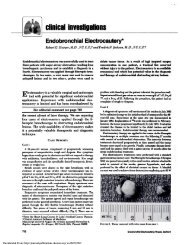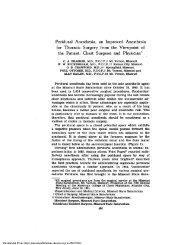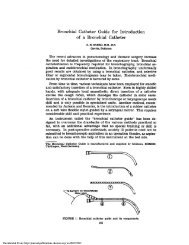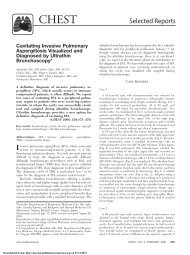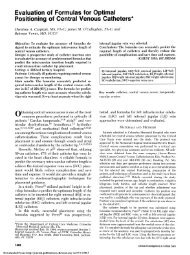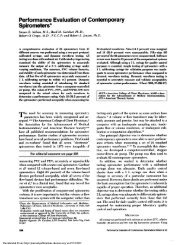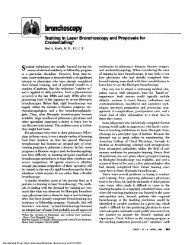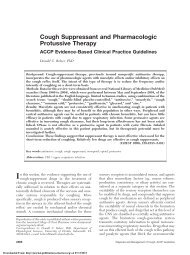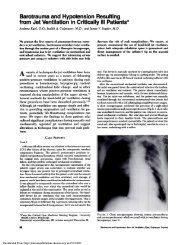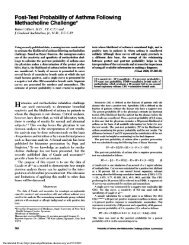Bronchoalveolar Lavage in the Normal Volunteer Subject* - Chest
Bronchoalveolar Lavage in the Normal Volunteer Subject* - Chest
Bronchoalveolar Lavage in the Normal Volunteer Subject* - Chest
Create successful ePaper yourself
Turn your PDF publications into a flip-book with our unique Google optimized e-Paper software.
z<br />
w<br />
CC<br />
w<br />
a-<br />
-j<br />
"Cm<br />
lm<br />
cLw<br />
w<br />
0<br />
w<br />
C)<br />
-j<br />
-j<br />
w<br />
U.<br />
0 -j<br />
z<br />
0w<br />
w<br />
LL.<br />
U-<br />
100<br />
98<br />
A. ALVEOLAR MACROPHAGES<br />
96<br />
94<br />
92<br />
90<br />
88<br />
86<br />
84<br />
____ 4~~~~~~4<br />
* *<br />
16 B. LYMPHOCYTES<br />
14<br />
12<br />
10<br />
8 * U s<br />
6- a. * * U +sd<br />
4 n 6r<br />
2 *u U<br />
*~~~* i *<br />
0O%U.<br />
8<br />
5-<br />
4,<br />
3<br />
2.<br />
3,<br />
C. NEUTROPHILS<br />
A<br />
A<br />
A<br />
A<br />
A&<br />
A<br />
A<br />
d<br />
s<br />
-sd<br />
sO<br />
A AA<br />
AM<br />
-A--*AA Ah e d.<br />
A<br />
ui _,A--A ___ .L -, over, for research purposes, idiosyncrasies oftechnique<br />
_<br />
D. EOSINOPHILS<br />
0<br />
* 0- 0<br />
OBSERVATIONS<br />
FIGURE 3. Scattergrams of <strong>the</strong> percentage of A, alveolar macrophages;<br />
B, lymphocytes; C, neutrophils; and D, eos<strong>in</strong>ophils (as<br />
determ<strong>in</strong>ed by analysis of cytocentrifuge preparation of BAL cells<br />
from 78 consecutive normal volunteer subjects).<br />
extremely rare and were similarly not <strong>in</strong>cluded <strong>in</strong> <strong>the</strong><br />
differential analysis.<br />
Viability of BAL Cells<br />
The viability (mean +±SD) of BAL cells was<br />
91.4 8.6 percent with a range from 66 to 100 percent.<br />
Viability of cells from seven subjects (9 percent) was<br />
less than 80 percent, but <strong>the</strong>re was no evident<br />
explanation for <strong>the</strong> lower than normal cell viability<br />
Safety and ComplicationslAdverse Reaction<br />
There were no complications of any consequence<br />
related to <strong>the</strong> performance of BAL <strong>in</strong> any subject.<br />
Virtually all subjects noted mild transient light headedness<br />
of 15 to 20 m<strong>in</strong>ute duration immediately<br />
278<br />
2<br />
Uo<br />
Downloaded From: http://journal.publications.chestnet.org/ on 07/13/2013<br />
0<br />
±sd<br />
-sd<br />
follow<strong>in</strong>g term<strong>in</strong>ation of <strong>the</strong> BAL. Approximately 50<br />
percent of <strong>the</strong> subjects reported be<strong>in</strong>g more tired than<br />
usual for up to 24 hours follow<strong>in</strong>g <strong>the</strong> BAL. Subjects<br />
were specifically requested to monitor for fever, but<br />
only seven reported any temperature elevation and <strong>in</strong><br />
only one subject was <strong>the</strong> elevation >37.7°C. This<br />
isolated subject noted onset offever (39.1C) and chills<br />
approximately four hours after <strong>the</strong> procedure which<br />
subsided over <strong>the</strong> next 24 hours without morbid<br />
sequelae. No cardiac arrhythmias were noted.<br />
DISCUSSION<br />
There is considerable variation <strong>in</strong> <strong>the</strong> manner <strong>in</strong><br />
which BAL is performed and <strong>the</strong> specimen processed<br />
<strong>in</strong> both cl<strong>in</strong>ical and research applications of BAL.<br />
There is little evidence to support <strong>the</strong> use of one<br />
technique over <strong>the</strong> o<strong>the</strong>r, and <strong>in</strong> all likelihood, if BAL<br />
specimens are processed similarly <strong>in</strong> an <strong>in</strong>dividual<br />
laboratory, results may be compared to <strong>the</strong> locally<br />
established norms. However, <strong>the</strong>re may be some<br />
danger <strong>in</strong> compar<strong>in</strong>g results obta<strong>in</strong>ed and published<br />
by o<strong>the</strong>r <strong>in</strong>vestigators who may have used a different<br />
size bronchoscope or process<strong>in</strong>g techniques. More-<br />
may also limit comparison of results of <strong>in</strong> vitro<br />
functional assays <strong>in</strong> which BAL cells are used. The<br />
purpose of <strong>the</strong> current study was not to promote or<br />
espouse a particular method, but ra<strong>the</strong>r to report on<br />
<strong>the</strong> subject-to-subject variability <strong>in</strong> BAL results found<br />
<strong>in</strong> a relatively large population of normal subjects<br />
when us<strong>in</strong>g rigidly controlled conditions.<br />
All bronchoscopies and process<strong>in</strong>g of <strong>the</strong> BAL<br />
specimens were performed by or under <strong>the</strong> direct<br />
supervision of one experienced <strong>in</strong>dividual, and all<br />
BAL was performed us<strong>in</strong>g <strong>the</strong> same diameter bronchoscope,<br />
<strong>the</strong> same type of fluid, <strong>the</strong> same relative<br />
location (l<strong>in</strong>gula), at <strong>the</strong> same time of day. The subject<br />
pool was also controlled by several criteria. Despite<br />
<strong>the</strong> uniformity of <strong>the</strong> BAL protocol, <strong>the</strong>re was considerable<br />
variability <strong>in</strong> both <strong>the</strong> percentage of return and<br />
cell number obta<strong>in</strong>ed (Table 1) and with <strong>the</strong> exception<br />
of BALs with low percentage return, <strong>the</strong>re was no<br />
correlation between cell number and percentage of<br />
return. There was also no correlation of ei<strong>the</strong>r value<br />
with any lung volume. Similarly, <strong>the</strong>re was no correlation<br />
ofnumbers of lavage cells per milliliter lavageate<br />
with any lung volume. Not surpris<strong>in</strong>gly <strong>the</strong>n, even<br />
though female subjects had significantly smaller lung<br />
volumes than males, <strong>the</strong>re was no correlation between<br />
cell numbers or percentage of return and <strong>the</strong> gender<br />
of <strong>the</strong> lavage subject and no significant gender-related<br />
differences <strong>in</strong> any lavage parameter. A possible explanation<br />
of this observation may be that similar surface<br />
area of lung was lavaged <strong>in</strong> all subjects irrespective of<br />
lung size. S<strong>in</strong>ce <strong>the</strong> same diameter bronchoscope was<br />
used for all subjects, it is likely that bronchi of nearly<br />
BAL <strong>in</strong> <strong>Normal</strong> <strong>Volunteer</strong> Subjects. 1. Technical Aspects (Ettensohn et al)



